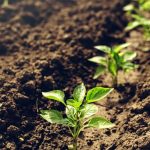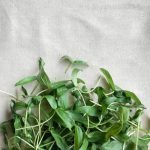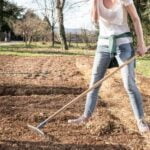When it comes to gardening vegetables, one of the most crucial aspects to consider is the soil. The type of soil you use can greatly impact the growth and overall health of your vegetable plants. Sandy, clay, and loamy soils each have their own unique qualities that can either benefit or hinder vegetable growth. Understanding soil pH levels, proper preparation techniques, and effective management of moisture and drainage are all important factors in maintaining healthy soil for successful vegetable gardening.
The type of soil used for gardening vegetables can make a significant difference in the quality and yield of your crops. Sandy soil drains quickly and warms up fast in spring, making it suitable for early planting of some vegetables.
Clay soil, while rich in nutrients, also tends to hold too much water which can suffocate plant roots if not properly managed. Loamy soil, a combination of sand, silt, and clay, is often considered ideal for vegetable gardening due to its balanced texture and ability to retain moisture while still providing adequate drainage.
In addition to the physical characteristics of the soil, understanding its pH level is essential for optimal vegetable growth. Different vegetables thrive in different pH ranges, so testing your soil and making necessary adjustments can help ensure that your plants have access to the nutrients they need for healthy development. It’s also important to properly prepare your soil before planting by removing any debris or weeds and incorporating organic matter such as compost or well-rotted manure.
Ultimately, maintaining healthy soil is a continuous process that requires careful attention to detail and consistent effort. By choosing the right fertilizers and amendments, managing moisture levels effectively, and addressing any common soil-related issues that may arise in your vegetable garden, you can create an environment where your plants can flourish year after year.
Types of Soil for Vegetable Gardening
When it comes to vegetable gardening, the type of soil you use can significantly impact the success of your plants. There are three main types of soil commonly used for vegetable gardening: sandy, clay, and loamy. Each type has its own unique characteristics that can influence how well your vegetables grow.
Sandy Soil
Sandy soil is known for its large particles and excellent drainage capabilities. This type of soil warms up quickly in the spring, which can be beneficial for getting a head start on planting your vegetable garden. However, sandy soil also struggles to retain moisture and nutrients, so frequent watering and fertilizing may be necessary to keep your vegetables healthy.
Clay Soil
Clay soil has tiny particles that hold onto water and nutrients, making it fertile but slow to drain. Vegetable gardens with clay soil may benefit from the addition of organic matter, such as compost or peat moss, to improve drainage and aeration. Additionally, incorporating sand into clay soil can help break up the dense texture and improve overall soil structure.
Loamy Soil
Loamy soil is considered ideal for vegetable gardening due to its balanced mixture of sand, silt, and clay. This type of soil offers good drainage while retaining essential moisture and nutrients for plant growth. If you have loamy soil in your garden, you’re already at an advantage when it comes to cultivating a thriving vegetable garden.
Regardless of which type of soil you have in your garden, it’s important to understand its unique qualities and make any necessary amendments to ensure optimal growing conditions for your vegetable plants. By selecting the right type of soil for your specific needs, you can set yourself up for a successful and bountiful harvest of delicious homegrown vegetables.
Understanding Soil pH Levels for Optimal Vegetable Growth
When it comes to vegetable gardening, understanding the pH levels of your soil is crucial for optimal growth and yield. Soil pH is a measure of the acidity or alkalinity of the soil, and it can significantly impact the ability of plants to take up nutrients. Most vegetables prefer a slightly acidic soil with a pH ranging from 6.0 to 6.8, but this can vary depending on the specific type of vegetable being grown.
It’s important to test the pH level of your soil before planting your vegetable garden. This can be done using a simple at-home testing kit or by sending a sample to a professional lab for analysis. Once you know the pH level of your soil, you can take steps to adjust it if necessary. Adding materials such as lime can raise the pH of acidic soils, while elemental sulfur can lower the pH of alkaline soils.
In addition to affecting nutrient availability, soil pH also plays a role in other aspects of plant health. For example, some vegetables are more susceptible to certain diseases in soils with an imbalanced pH. By ensuring that your soil has the right pH level for the vegetables you want to grow, you can create an environment that promotes healthy growth and helps prevent issues like nutrient deficiencies and pest problems.
| Vegetable | Optimal Soil pH Range |
|---|---|
| Carrots | 8-7.0 |
| Tomatoes | 0-6.8 |
| Potatoes | 0-7.0 |
Best Practices for Preparing Soil for Vegetable Gardening
When it comes to vegetable gardening, the importance of soil preparation cannot be overstated. The quality and composition of the soil directly impact the growth and health of your vegetable plants. It is essential to take the necessary steps to prepare the soil before planting your vegetables.
One of the first steps in preparing soil for gardening vegetables is to assess the type of soil you have in your garden. As mentioned in a previous section, there are three main types of soil: sandy, clay, and loamy. Each type has its own characteristics and will require different approaches to prepare for vegetable gardening.
Once you have determined the type of soil in your garden, it’s important to address any issues that may exist. For example, if you have heavy clay soil, you may need to amend it with organic matter to improve its texture and drainage. On the other hand, sandy soil may require adding compost or other organic materials to increase its water retention capacity.
It’s also crucial to test the pH levels of your soil before planting vegetables. Most vegetables prefer a slightly acidic to neutral pH range. Making adjustments to the pH levels can be done by adding materials such as lime to raise pH or sulfur to lower it.
| Soil Preparation Step | Key Considerations |
|---|---|
| Assess Soil Type | Determine if soil is sandy, clay, or loamy and address specific needs accordingly. |
| Address Soil Issues | Improve texture and drainage for heavy clay soil or increase water retention for sandy soil using organic matter. |
| Test Soil pH | Ensure that pH levels are optimal for vegetable growth by making necessary adjustments with lime or sulfur. |
Choosing the Right Fertilizers and Soil Amendments for Vegetable Gardens
When it comes to vegetable gardening, choosing the right fertilizers and soil amendments is crucial for the success of your garden. Different vegetables have different nutrient needs, so it’s important to understand what your specific plants require. In this section, we will discuss the importance of fertilizers and soil amendments for vegetable gardens, as well as how to choose the right ones for your plants.
Understanding Nutrient Needs
Before you can choose the right fertilizers and soil amendments for your vegetable garden, it’s important to understand the specific nutrient needs of the plants you are growing. Different vegetables require different levels of nitrogen, phosphorus, and potassium, as well as other micronutrients. Conducting a soil test can help you determine what nutrients are lacking in your soil and what needs to be added.
Choosing the Right Fertilizers
Once you know what nutrients your soil needs, you can choose the right fertilizers to supplement them. There are many different types of fertilizers available, including organic and synthetic options. Organic fertilizers are derived from plant or animal sources and provide a slow release of nutrients over time. Synthetic fertilizers, on the other hand, deliver a quick burst of nutrients but can also lead to nutrient imbalances if not used carefully.
Using Soil Amendments
In addition to fertilizer, adding soil amendments can help improve the overall quality of your soil for gardening vegetables. Common soil amendments include compost, peat moss, and aged manure. These amendments can improve soil structure, water retention, and nutrient availability. It’s important to research which amendments are best for the specific vegetables you are growing and incorporate them into your gardening routine.
By understanding the nutrient needs of your vegetables and choosing the right fertilizers and amendments accordingly, you can ensure that your plants have everything they need to thrive. Properly nourished plants will produce higher yields and better-tasting fruits and vegetables for you to enjoy at harvest time.
Managing Soil Moisture and Drainage for Healthy Vegetable Plants
To ensure healthy vegetable plants, proper management of soil moisture and drainage is crucial. The right levels of moisture will allow the plants to thrive, while effective drainage will prevent waterlogged conditions that can cause root rot and other issues.
Here are some best practices for managing soil moisture and drainage for healthy vegetable plants:
- Watering: Proper watering is key to managing soil moisture. Different vegetables have different water needs, so it’s important to understand the specific needs of the plants in your garden. Generally, it’s best to water deeply and infrequently to encourage deep root growth.
- Improving Drainage: If you have clay or compacted soil, amending it with organic matter such as compost can improve drainage. Raised beds can also help with drainage by providing better aeration and preventing water from pooling around the roots of the plants.
- Mulching: Applying mulch around vegetable plants can help regulate soil moisture by reducing evaporation and protecting the soil from drying out too quickly. Organic mulches like straw or shredded leaves also contribute to soil health as they break down over time.
Proper management of soil moisture and drainage not only promotes healthy plant growth but also helps prevent common issues like wilting, yellowing leaves, and diseases that thrive in overly wet conditions. By paying close attention to these factors, gardeners can create an environment that supports optimal growth for their vegetable crops.
Common Soil-Related Issues in Vegetable Gardens and How to Address Them
Vegetable gardening can be a rewarding experience, but it also comes with its own set of challenges, especially when it comes to the soil. Here are some common soil-related issues that gardeners may encounter when growing vegetables and how to address them:
1. Poor Drainage: One of the most common soil-related issues in vegetable gardens is poor drainage, which can lead to waterlogged soil and root rot. Sandy soil tends to drain too quickly, while clay soil drains too slowly. To address poor drainage, consider incorporating organic matter such as compost or aged manure into the soil. This will help improve soil texture and structure, allowing for better drainage.
2. Nutrient Deficiency: Another common issue in vegetable gardens is nutrient deficiency, which can lead to stunted growth and poor yields. To address this problem, it’s important to have your soil tested to determine its nutrient levels. Based on the results, you can then supplement the soil with the necessary nutrients through fertilizers or organic amendments such as bone meal or fish emulsion.
3. Soil Compaction: Soil compaction can restrict root growth and reduce a plant’s ability to take up water and nutrients. To address this issue, avoid walking on the garden beds and use raised beds or containers for planting if compaction is a persistent problem.
By addressing these common soil-related issues in vegetable gardens, gardeners can ensure that their plants have the best possible growing conditions for a successful harvest.
Tips for Maintaining Healthy Soil for Long-Term Vegetable Gardening Success
In conclusion, the success of your vegetable garden greatly depends on the health and quality of the soil you choose. Whether it’s sandy, clay, or loamy soil, understanding its pH levels and making the necessary amendments will ensure optimal growth for your vegetable plants. By following best practices for preparing the soil, choosing the right fertilizers, and managing moisture and drainage, you can create an environment that promotes healthy and robust vegetables.
One key aspect of long-term success in vegetable gardening is maintaining healthy soil. Regular testing and understanding the soil’s composition are essential for making informed decisions about amending and fertilizing. By addressing common soil-related issues such as compaction or nutrient deficiencies promptly, you can prevent problems from escalating and ensure a thriving garden.
By implementing these strategies for maintaining healthy soil, you can set your vegetable garden up for long-term success. With proper care and attention to the condition of your soil, you can enjoy bountiful harvests year after year. Remember that healthy soil is the foundation of a successful vegetable garden, so prioritize its care to reap the rewards of delicious homegrown produce.

If you’re looking to get into vegetable gardening, or are just looking for some tips on how to make your current garden better, then you’ve come to the right place! My name is Ethel and I have been gardening for years. In this blog, I’m going to share with you some of my best tips on how to create a successful vegetable garden.





